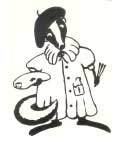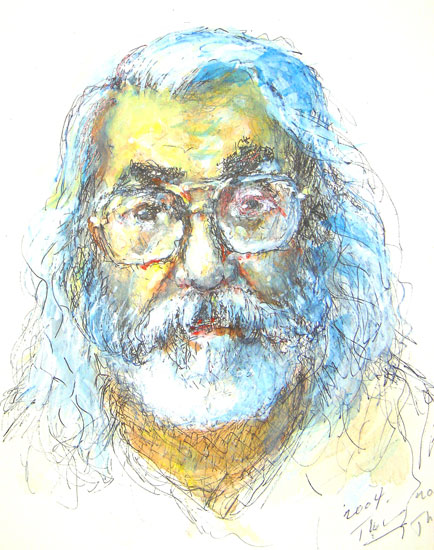Skunk - WSJ: Why Presidential Portraiture Lost Its Stature

Markand Thakar
A few years back, while browsing through the Wall Street Journal of January 18, 2007, SKUNK came across an art-based article: "Why Presidential Portraiture Lost Its Stature."
There is no intent to give the impression that art critiques in other publications are free of faults. Articles published in neighborhood news-papers - along with the likes of the New York Daily News and New York Post - as well as the house organs of corporations and art schools are usually nothing more than appeasements to advocates of the Politically Correct; payoffs to advertisers, associates or personal contacts. Rarely are the critics any more than BFA's with minors in English. Yet, SKUNK can't recall ever reading an article about artists and their work that was as quite as jejune as: "Why Presidential Portraiture Lost Its Stature," published in the Wall Street Journal.
The fault for this trivial article must rest with the editors of the WSJ, and not with the writer of the article - who appears to be writing about a subject he stumbled upon while auditing a class on art history at a community college.
Obviously, the editors of the WSJ couldn't have had much respect for the arts, otherwise, to discuss portraiture and portrait painters they'd designate someone to write the article who was considered to be as knowledgeable on that subject as others who write for the WSJ are thought to be about commerce and money matters.
The article in question was illustrated with two photos of portraits: one of Gerald Ford by Everett Raymond Kinstler (a former League instructor) and the other of George Washington by Gilbert Stuart. While mentioning something about Sargent and a number of non-professional portraitists - the article rambled on about portraiture - claiming it to have been a once-august genre.
It should be noted that Sargent, one of the truly gifted portrait painters, eventually had his fill of catering to the egos of his wealthy sitters. Today's prominent commercial portrait painters - though none are known to have attained the stature or obtained the kind of fees of a Sargent - continue to sell their somewhat inferior skills - while becoming little more than cosmeticians. After all, when thousands of dollars are being paid for a portrait, whether at the behest of a society, corporation, branch of government or wealthy individual - the expectation is that the sitter (depending upon his or her sex - or sexual orientation) will appear to be handsomer, prettier, younger, sager, taller, thinner, more authoritative or you name it - all of which, intended to impress a prospective viewer with a flattering impression of the sitter.
These days, when idiot-savant money makers: such as our bought-with-big- bucks mayor, are venerated - portrait-painters, also wishing to get rich, needn't go to Las Vegas: where prostitution is legal, to practice their profession. One of the main reasons: "Why Presidential Portraiture Lost Its Stature" is that today's portrait painters have become so specialized, is that most lack the abilities to make a reputation as a major artist - ergo, if they wish to earn a living, they must cater to the demeanor- and cosmetic-enhancing demands of their sitters.
Working during the middle-years of the twentieth century, Brackman, (a former League instructor) who painted the portrait for the film: "Portrait of Jenny," claimed that he would refuse commissions to paint the portrait of any woman who had lost her youthful looks (he claimed this occurred at thirty). Perhaps a sexist, but - no cosmetician was he - or so he claimed.
The writer of the Wall Street article appeared to be ignorant of the kind of process (according to what Ray Kinstler had once mentioned to the writer) that today's commercial portrait painters rely on - if they expect to sell their portraits. With few exceptions, the method followed by his generation's successful portrait painters was as follows: having selected the portraitist based on a viewing of the portraitist's prior works or by his or her reputation - the prospective sitter, ordinarily, would then go to the portraitist's studio - at which time the portraitist would take numerous photos - all with slightly varying poses. The sitter would then select a photo from which the portrait would be painted.
Despite the inability of many portrait painters to deal with any but a rigidly posed sitter - and the understandable reluctance of most people, including professional models, to pose rigidly for extended periods of time - a top-of-the-line commercial portrait painter, such as Mr. Kinstler, made me aware that despite such limitations he always tried to have at least one actually posed painting session.
The ensuing oil portrait: much like a high-priced, commercial photo-portrait - ends up being a superficial, though often well painted ego-building glorification of a sitter - for which big bucks were paid. As a consequence, the resultant superficiality of the final commissioned painted portrait (much like the now-Photo-Shopped, posed, photographic portrait), is not really due to the shortcomings of the portrait-painter-artist. Presidential Portraiture has lost its stature - assuming that it ever had it, as art - has lost it due to the exigencies of our time. Money talks - and skillful, truth-searching artistic endeavors (currently considered nothing more than bullshit) walk.
Of course, today's commercial portrait painter is no more guilty of producing a superficial rendition of reality for a price, than Nevada's lady of the night - both offer their services for a price, for delivering something that could have been significant - instead of the meaningless sale of a superficial facade and affection.
In summary, much like an artist's representative, agent or gallery, most hookers also have an agent of some sort - and rely on him or her to provide a money-paying client. The artist's representative, agent or gallery, makes the necessary arrangements - the sitter pays to be satisfied - and the painter-artist uses his or her ability to gratify the sitter. There is an exception, though, when wishing to be known as patrons of the arts, well-heeled sitters, often willingly pose for many hours over the course of many days in order to acquire a portrait by a prominent, well-known, accredited-as-museum-quality painter. However, virtually all others, wealthy or not, expect a flattering version of themselves when purchasing a portrait.
And, that's probably the most significant reason: Why Presidential Portraiture Lost Its Stature.
*

